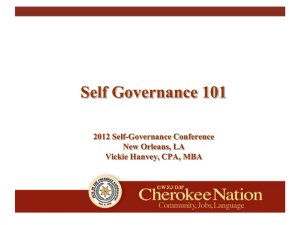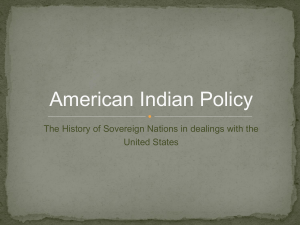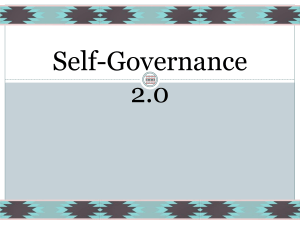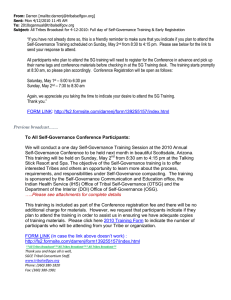Cherokee Nation
advertisement
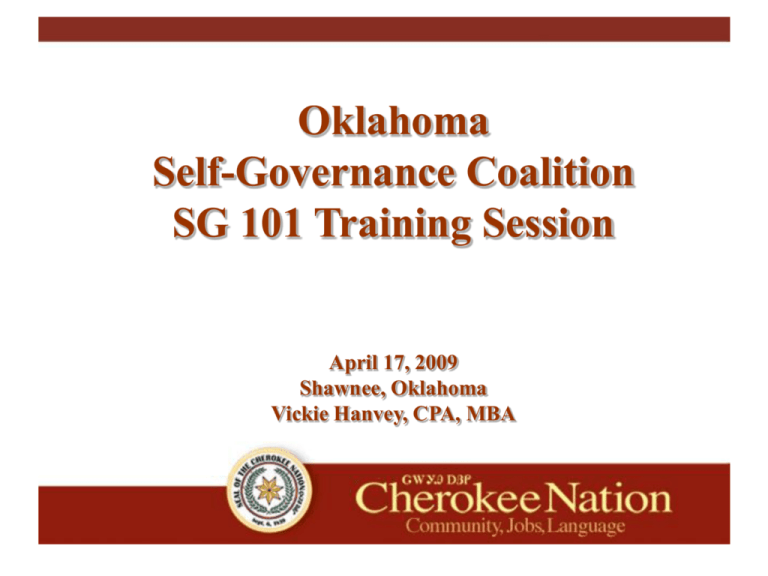
Oklahoma Self-Governance Coalition SG 101 Training Session April 17, 2009 Shawnee, Oklahoma Vickie Hanvey, CPA, MBA Self-Governance • Since time immemorial • Treaties are Nation-to-Nation contracts Tribal governments entered into treaties prior to the formation of the U.S. Treaties of the Cherokee Nation Date of Treaty Area in Acres Date of Treaty Oct. 2, 1798 Area in Acres 609,280 1721 1,678,720 Nov. 24, 1755 5,526,400 Oct. 14, 1768 544,000 Oct. 24, 1804 86,400 Oct. 18, 1770 2,880,000 Oct. 25, 1805 695,040 96,000 Oct. 27, 1805 800 160,000 Jan. 7, 1806 1772 6,486,400 279,680 375,680 Mar. 22, 1816 Sept. 14, 1816 672,000 May 17, 1775 14,464,000 1,696,000 94,720 2,194,560 2,560 220,800 June 1, 1773 3,372,160 July 8, 1817 373,120 1,541,120 Feb. 27, 1819 535,680 May 20, 1777 1,312,640 1,541,120 July 20, 1777 2,824,960 986,880 1,126,400 May 6, 1828 May 31, 1783 1,056,000 Dec. 29, 1835 Nov. 28, 1785 352,000 4,609,280 586,880 1,611,520 2,198,400 711,680 July 2, 1791 462,080 July 19, 1866 3,020,800 949,760 1,233,920 Self-Governance • Cherokee Nation ceded over 81 million acres Self-Governance In return, the federal government would protect and respect the Nation’s right to govern Self-Governance • U.S. Constitution recognizes Indian nations as governments • U.S. Supreme Court has affirmed that Indian tribes retain their governmental powers unless specifically limited by law. Self-Governance • • Cherokee case law from the 1830’s forms the basis for the unique Federal/Tribal relationship today. Cherokee Nation vs. Georgia Worchester vs. Georgia Chief Justice John Marshall Tribes are “distinct, independent political communities, retaining their original natural rights.” “domestic dependent Nation” Self-Governance “That from time immemorial the Cherokee nation have composed a sovereign and independent state, and in this character have been repeatedly recognized, and still stand recognized by the United States, in the various treaties subsisting between their nation and the United States.” Cherokee Nation vs. Georgia, 1831 Self-Governance “They (the Cherokees) have been admitted and treated as a people governed solely and exclusively by their own laws, usages, and customs within their own territory, claiming and exercising exclusive dominion over the same… still claiming absolute sovereignty and self government over what remained unsold.” Cherokee Nation vs. Georgia, 1831 Self-Governance “They (the Cherokees) have never been, by conquest, reduced to the situation of subjects to any conqueror, and thereby lost their separate national existence, and the rights of self government…” Cherokee Nation vs. Georgia, 1831 Self-Governance Indian Self-Determination Policy recognizes the Indian governments’ rights to self-govern and administer their own programs and operations. Self-Governance Statutory Authority: • P.L. 93-638, as amended 1975 1987 1988 1992 1994 2000 ISDEA Arizona Republic “Fraud in Indian Country” Tribal Self-Governance Demonstration Project DOI Demonstration Project extended to IHS Authorization of SG as permanent option for DOI Authorization of SG as permanent option for IHS Self-Governance (ISDEA) Indian Self-Determination and Education Assistance Act Title I Title II Title III Title IV Title V Indian Self-Determination Act Indian Education Programs Tribal Self-Governance Demonstration Act (repealed) Department of Interior Indian Health Service Self-Governance (ISDEA) Advancement Title IV Amendments • Provisions to ensure consistency between Title IV and Title V • Provisions to clarify statutory requirements governing constructionrelated matters • Provisions to clarify the terms for the assumption and administration of non-BIA programs Title VII Other HHS Agencies • Feasibility of demonstration for Non-IHS • 2003 Study to Congress • Identifies 11 HHS programs could be included in demonstration Self-Governance Allows the Nation to negotiate a single compact and funding agreement for all programs, services, functions and activities. Self-Governance • Self-Governance allows tribes the flexibility to re-design programs and reallocate budgets to meet local needs Self-Governance OMB Circular A-87 still applies Must be consistent with applicable law and regulations Regulations can be waived upon request Not required to follow Federal policy Self-Governance • Major components of an Ongoing Process Planning Negotiations Implementation Monitoring

